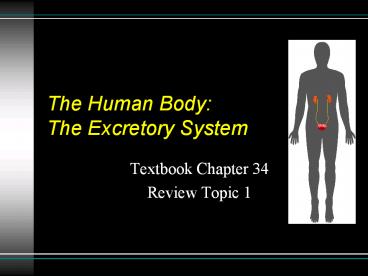The Human Body: The Excretory System - PowerPoint PPT Presentation
1 / 23
Title:
The Human Body: The Excretory System
Description:
The Human Body: The Excretory System Textbook Chapter 34 Review Topic 1 Function Removes toxins and wastes which build up in the body as a result of metabolism ... – PowerPoint PPT presentation
Number of Views:319
Avg rating:3.0/5.0
Title: The Human Body: The Excretory System
1
The Human BodyThe Excretory System
- Textbook Chapter 34
- Review Topic 1
2
Function
- Removes toxins and wastes which build up in the
body as a result of metabolism - Regulates the amount of fluid and salts in the
body and maintains pH of the blood - Helps regulate homeostasis
3
Parts
- Lungs
- Excretes carbon dioxide
- Skin
- Excretes water and salts contained in sweat
- Kidneys
- Major excretory organ in the body
4
Kidneys
- Bean-shaped
- Filters out wastes, water and salts from the
blood - Two regions
- Renal cortex outer region
- Renal medulla inner region
5
- Contains microscopic tubules and blood vessels
- Renal pelvis center of kidney where these
filters are found
6
- Nephron filtration
- Each kidney has 1 million filtering units called
nephrons - Blood enters each Nephron through a long tube
surrounded by capillaries called a glomerulus - Surrounded by the Bowmans capsule
7
(No Transcript)
8
- Renal artery transports nutrients and wastes to
the kidney - Branches into smaller blood vessels forming the
glomerulus - Blood vessel walls are thin and under high
pressure
9
- Urea nitrogenous waste product containing water
and substances dissolved in water - Pushed through capillary walls into the Bowmans
capsule - Red blood cells and proteins are too large and
remain in the blood stream
10
- Reabsorption/formation of urine
- Filtrate collects in the Bowmans capsule and
flows through renal tubules (loop of Henle and
collecting tubule) - Most water and useful substances (ex. glucose,
minerals) are reabsorbed back into blood stream
(reabsorption)
11
(No Transcript)
12
- Excess fluids and toxic substances are collected
to form urine - Leaves the kidneys through ducts called ureters
- Urine is stored in the urinary bladder
- Exits the body through the urethra
13
(No Transcript)
14
- Each kidney filters 180 L of blood a day in
adults to produce 1.5 L of urine - Process requires large amounts of energy
- Use 20-25 of your bodys oxygen intake for their
internal energy requirements! - Controls pH balance by absorbing or filtering out
acids or bases to regulate pH of the blood
15
- Urinary System BrainPop
16
Kidney Disorders
- Infections
- Start as bladder infections which spread to
kidney - Fever, chills, mid-/lower-back pain
- Can be caused by blockages
- If untreated, kidneys can scar causing a loss in
function - Can be treated with antibiotics
17
- Nephritis
- Inflammation (painful swelling) of the glomeruli
- Cause by blockages
- Blood in urine, swelling of body tissues, protein
in urine - Can improve on its own but may require a special
diet or prescription drugs to treat the infection
18
- Kidney Stones
- Crystallized solid (calcium compound) which forms
in the kidney - Small stones can be passed out in urine
- Larger stones are broken up using ultrasonic
sound waves or removed using surgery
19
(No Transcript)
20
- Diabetes/High Blood Pressure
- Causes reduced kidney function or kidney failure
- Illegal/Prescription Drugs
- Can cause kidney damage
21
Treatments
- Dialysis
- An artificial
- kidney machine
- filters out wastes
- and toxins from
- a patients blood
22
- Two types
- Blood is passed through the machine temporarily
to be filtered and cleaned, then returned (3-4
hours/3 days week) - Membrane lining the abdomen acts as an artificial
kidney by injecting it with a special fluid
through a small tube attached to the patients
body to collect draining wastes (30-40 min/daily)
23
(No Transcript)

